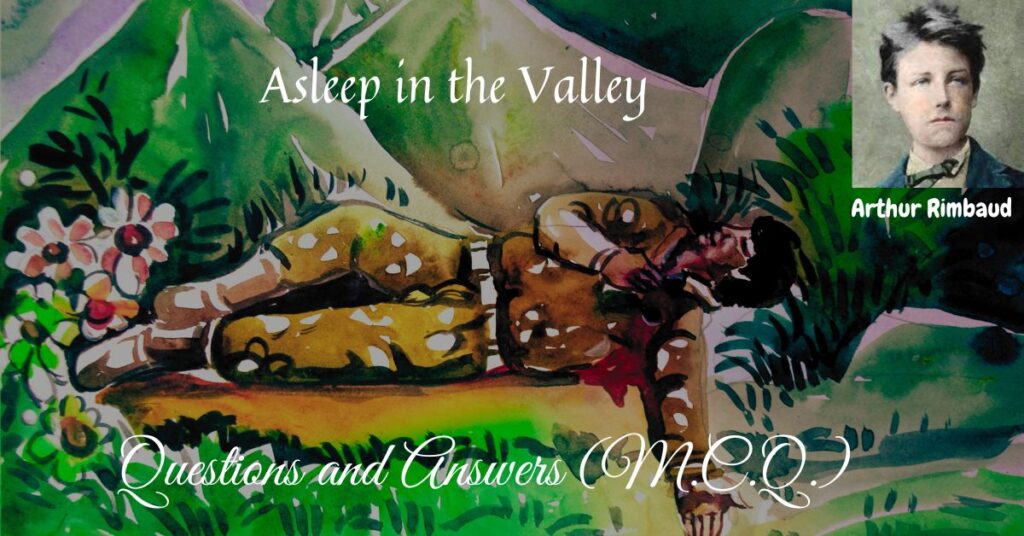
1. Who wrote the poem ‘Asleep in the Valley’? –
A) William Shakespeare B) Alfred Tennyson C) William Wordsworth D) Arthur Rimbaud
Ans. D) Arthur Rimbaud
2. The poem ‘Asleep in the Valley’ is –
A) a sonnet B)an ode C) a song D) lyric
Ans. A) a sonnet
3. ‘Asleep in the Valley’ is a –
A) Petrarchan sonnet B) Shakespearean sonnet C) Spenserian sonnet D) Hopkinian sonnet
Ans. A) Petrarchan sonnet
4. The poem is –
A) devotional B) anti-war C) descriptive D) natural
Ans. B) anti-war
5. The colour of the valley is –
A) white B) green C) yellowish D) blue
Ans. B) green
6. The stream in the valley flows –
A) slowly B) fast C) in a winding course D) with a dancing movement
Ans. A) slowly
7. The phase ‘long strands of silver’ refers to the –
A) clouds B)grass C) sun D) stream
Ans. D) stream
8. What is the colour of the stream? –
A) black B) golden C) green D) silvery
Ans. D) silvery
9. The grass appears ________ in the valley. –
A) dry B) tall C) dense D) bright
Ans. D) bright
10. The sunrays fall from –
A) the sky B) behind the mountain C) above the trees D) the mountaintop
Ans. D) the mountaintop
11. The rays of the sun are compared with –
A) a stream B)the fire C) the beauty of a flower D) none of these
Ans. A) a stream
12. ______________ fills the valley with light. –
A) the rays of the star B) the rays of the moon C) the rays of the sun D) None of these
Ans. C) the rays of the sun
13. The soldier described in the poem is –
A) old B) young C) very young D)child-like
Ans. C) very young
14. The soldier is open-mouthed because –
A) it is his habit B) he wants sunlight to enter his mouth C) he is killed suddenly D) he wants to say something
Ans. C) he is killed suddenly
15. The mouth of the soldier is open because –
A) it is his habit B) he is feeling hot C) he is sleeping peacefully D) none of the above
Ans. C) he is sleeping peacefully
16. The soldier’s head is supported by –
A) a pillow of logwood B) a pillow of fern C)a pillow of thick grasses D)none of these
Ans. B) a pillow of fern
17. The soldier’s pillow is made of –
A) flowers B)fern C) grass D)leaves [H.S. = 2017]
Ans. B) fern.
18. The soldier lying on –
A) soil B) rocky surface C) undergrowth D) light grass
Ans. C) undergrowth
19. The word ‘undergrowth’ suggests –
A) a stream B) plenty of flowers C) a small valley D) bushes and shrubs
Ans. D) bushes and shrubs
20. The soldier looks –
A) angry B) handsome C) healthy D) pale
Ans. D) pale
21. The soldier’s bed is green and __________.
A) sun-soaked B) soft C) uneven D) damp
Ans. A) sun-soaked
22. The feet of the soldier is –
A) on ferns B) among the flowers C) in the water D) on a piece of stone
Ans. B) among the flowers
23. The soldier’s smile is like –
A) a spark of light B) beautiful C) an infant’s D)a shy maid’s
Ans. C) an infant’s
24. The innocence of the soldiers is expressed through his –
A) sleep B) smile C) posture D) weapons
Ans. B) smile
25. The smile of the soldier in the poem ‘Asleep in the Valley’ is –
A) gentle B) foolish C) witty D) cunning [H.S. 2015]
Ans. A) gentle
26. What is described as ‘gentle, without guile’? –
A) the rays of the sun B) the stream that flows through the valley C) the soldier’s smile D)the soldier’s face
Ans. C) the soldier’s smile
27. The poet addressed ____________ in this poem. –
A)God B) the Sun C) Nature D) the stream
Ans. C) Nature
28. Why does the poet address nature?
A) to give back the life of the soldier B) to keep the soldier warm C) to fulfil the dreams of the soldier D) none of the these
Ans. B) to keep the soldier warm
29. Nature is pleaded to keep the soldier –
A)pleasant B)warm C)asleep D)peaceful [H.S. = 2019 & 2022]
Ans. D) warm.
30. As the soldier is sleeping in the open air, he may ___________. –
A) catch cold B) enjoy his sleep C)be stung by some insects D) awaken very soon
Ans. A) catch cold
31. The insects are –
A) hopping B)buzzing C) chirping D)humming
Ans. D)humming
32. _______________ may disturb the soldier’s rest? –
A) heat of the sun B) the singing of birds C) the humming of insects D) none of these
Ans. C) the humming of insects
33. One of the soldier’s hands is resting on –
A)his breast B) upon flowers C) his head D) on the ground
Ans. A) his breast
34. How many red holes are there on the soldier’s body?
A) three B) two C) one D) four
Ans. B) two
35. The humming insects don’t disturb him because –
A) he is dead B) he is peaceful C) he is a nature lover D) he is violent
Ans. A) he is dead
36. The soldier sleeps in the –
A) night B) dusk C) twilight D) sunlight
Ans. D) sunlight
37. One hand of the soldier is on his –
A) face B)gun C) breast D)side [H.S. = 2016]
Ans. C) breast
38. The marks of wounds of the soldier are –
A) on his head B) on his chest C) in his side D) in his leg [H.S. = 2018 & 2022]
Ans. C) in his side.
39. The words ‘red holes’ mean –
A) spots of blood clots B) red flowers in the valley C) bullet wounds D) none of these [H.S. = 2020]
Ans. C) bullet wounds.
40. The poem ends with a __________note. –
A) shocking B) delightful C) satisfactory D) none of these
Ans. A) shocking
41. This poem reflects –
A) the pity of war B) the glory of war C) the beauty of the valley D) none of these
Ans. A) the pity of war
42. What is the theme of this poem? –
A) the futility of war B) the celebration of peace C) the brotherhood of man D) the bravery of soldiers
Ans. A) the futility of war
43. What kind of poetry does the poet use in the poem? –
A) satirical B) lyrical C) rhetorical D) epic
Ans. B) lyrical
44. The setting of this war goes back to –
A) World War I B) World War II C) 1870s Europe D) The Cold War
Ans. C) 1870s Europe
45. Rimbaud’s nationality was –
A) French B) German C) Dutch D) Russian
Ans. A) French
Read more about:
∎ ‘Asleep in the Valley’ by Arthur Rimbaud – questions and answers(S.A.Q.), class 12, WBCHSE
∎ ‘Asleep in the Valley’ by Arthur Rimbaud – questions and answers(L.A.Q.), class 12, WBCHSE
